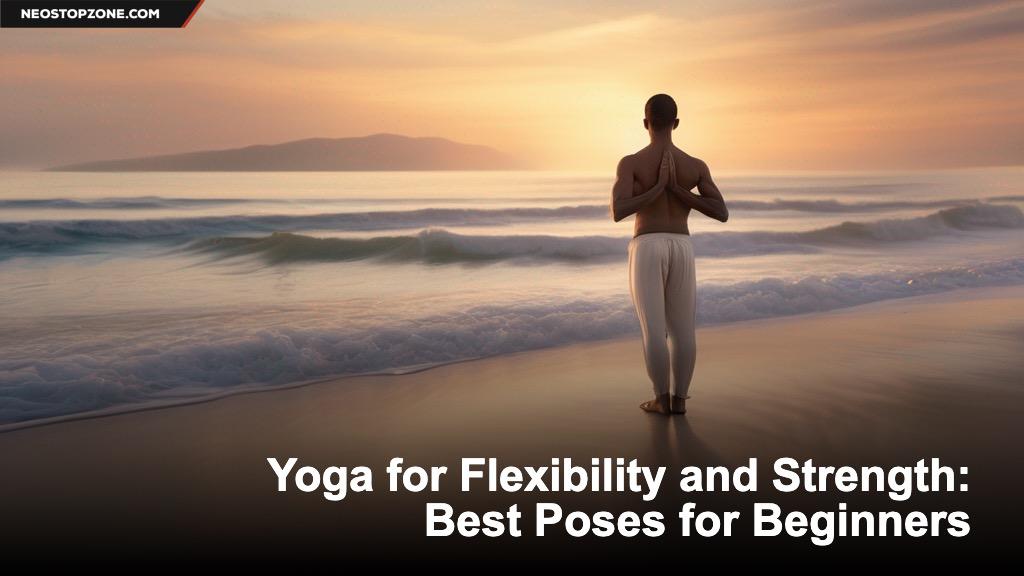
Introduction:
Yoga is a holistic practice that offers numerous physical and mental benefits. It combines controlled movements, breathwork, and mindfulness to enhance flexibility, strength, and overall well-being. If you’re a beginner looking to embark on a yoga journey, this article will guide you through some of the best yoga poses to improve flexibility and build strength. So, roll out your mat and let’s get started!
Mountain Pose (Tadasana):
The Mountain Pose is a foundational pose that helps establish a strong and grounded posture. Stand tall with your feet together, distribute your weight evenly, and engage your core. Relax your shoulders and lengthen your spine. This pose improves body awareness and promotes proper alignment.
Downward Facing Dog (Adho Mukha Svanasana):
Downward Facing Dog is a popular pose that stretches the entire body. Start on all fours, then lift your hips up and back, forming an inverted V shape. Press your palms firmly into the mat, relax your neck, and press your heels down. This pose strengthens the arms, shoulders, and legs while increasing flexibility in the hamstrings and calves.
Warrior I (Virabhadrasana I):
Warrior I pose cultivates strength and stability. Begin in a lunge position, with your right foot forward and left foot back. Raise your arms overhead, keeping your shoulders relaxed. Square your hips towards the front, bend your front knee, and sink into a deep lunge. This pose builds leg strength and opens up the chest and shoulders.
Tree Pose (Vrikshasana):
Tree Pose is excellent for improving balance and focus. Stand tall and shift your weight onto your left foot. Place your right foot on your inner left thigh or calf, avoiding the knee joint. Bring your hands to prayer position in front of your heart. Engage your core and find a focal point to help maintain balance. This pose strengthens the legs and improves concentration.
Bridge Pose (Setu Bandhasana):
Bridge Pose is an effective pose for strengthening the back, glutes, and legs. Lie on your back, bend your knees, and place your feet hip-width apart. Press your feet into the mat, lift your hips, and interlace your fingers beneath you. Roll your shoulders back and open your chest. This pose also helps release tension in the lower back.
Child’s Pose (Balasana):
Child’s Pose is a restorative pose that stretches the back and hips. Begin on all fours and then sit back on your heels, lowering your forehead to the mat. Extend your arms forward or rest them alongside your body. Breathe deeply and relax. This pose gently stretches the spine, hips, and ankles, promoting relaxation and stress relief.
Conclusion:
Incorporating yoga into your fitness routine is a fantastic way to enhance flexibility, build strength, and cultivate overall well-being. The poses mentioned above are just a starting point for beginners. As you progress, you can explore more advanced poses and sequences. Remember to practice with mindfulness, listen to your body, and always prioritize your safety. So, unroll your mat, take a deep breath, and enjoy the transformative journey that yoga offers.
FAQs:
1. Can yoga help me lose weight?
Yoga can aid in weight loss by increasing metabolism, building lean muscle mass, and promoting mindfulness, leading to healthier eating habits.
2. How often should I practice yoga?
Consistency is key. Aim for at least 2-3 yoga sessions per week to experience noticeable benefits. However, even practicing once a week can still be beneficial.
3. Is yoga suitable for all ages?
Absolutely! Yoga can be adapted to suit all ages and fitness levels. From children to seniors, everyone can enjoy the benefits of yoga.
4. Can yoga help with stress and anxiety?
Yes, yoga is known for its stress-relieving properties. The combination of movement, breathwork, and mindfulness helps reduce stress and anxiety levels.
5. Do I need to be flexible to start yoga?
No, flexibility is not a prerequisite for practicing yoga. Yoga actually helps improve flexibility over time, so anyone can start regardless of their current flexibility level.
